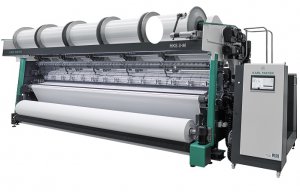
Karl Mayer detects increasing demand in Vietnam
The fabric produced in Shanghai was made completely from polyester and was patterned by transfer printing and then finished with a functional agent.

24th October 2014
Knitting Industry
|
Obertshausen
 Karl Mayer demonstrated its high-speed tricot machines at ITMA ASIA + CITME 2014 in Shanghai, where a COPCENTRA 2K+E from Karl Mayer LIBA was producing stretch tulle for ladies wear in red.
Karl Mayer demonstrated its high-speed tricot machines at ITMA ASIA + CITME 2014 in Shanghai, where a COPCENTRA 2K+E from Karl Mayer LIBA was producing stretch tulle for ladies wear in red.
During the leading trade fair, an HKS 2-M was also producing a stable textile, which, with it fine-mesh grid structure, can be treated with a functional finish whilst still remaining breathable.
The light and airy jumpsuit, with its flowing forms, is a stylish, casual piece that can be worn as party wear or casual wear. This sleeveless flying suit was made from a fabric produced on a COPCENTRA 2K+E, which can process stretch and non-stretch yarns at the same time.
This high-speed tricot machine, with its short-stroke, compound needle system and two guide bars, had a working width of 174" and a gauge of E 32 and was reaching a speed of 3,100 min-1. The output was 62 m/h and it was processing matt polyamide 6 and semi-matt Lycra, type 279W. The COPCENTRA 2K+E handles the yarns gently and can reach high speeds, even when processing microfibres, the company reports.
This is because the machine uses guide needles with rounded edges. Other technical features of this high-speed tricot machine are its temperature control system, the EBA electronically controlled, mechanical yarn feed system for constant yarn run-in values as standard, and an automatic beam end shut-off device, which reacts to the impulses from a sensor at the roller arm of the warp beams.
The new HKS 2-M was producing a fabric weighing just under 90 g/m2 for use in sportswear. This high-speed, two-bar tricot machine was operating in a gauge of E 28 and, with a speed of 3,000 min-1 and a working width of 210". It was producing roughly 86 m of fabric per hour.

Other advantages of this new machine include its ease of handling and reliable, accurate operation. This is due to its design with tried-and-tested components, such as the KAMCOS computer platform, electronic speed control of the main drive and electronic control of the fabric take-off and yarn feed systems.
This is said to allow the machine to produce smooth warp-knitted fabrics for a variety of applications, ranging from mattress covers, furnishing velour and nets, through sports goods and shoe fabrics, to printing grounds.
The fabric being produced in Shanghai was made completely from polyester and had a dense surface with tiny, regular openings in it. It was patterned by transfer printing and then finished with a functional agent.
Aurich Textilien finished the fabric with an oil and water repellent, fluorocarbon finish and also with an acrylate coating to keep the wearer dry, even in heavy rain. The oleo and hydrophobic agent was applied in a dipping bath and then squeezed into the textile with the liquor in the padder.
This ensured that the textile was impregnated on both sides. After this first processing stage, the acrylate dispersion was applied using a doctor blade in a wet-on-wet process. Finally, the textile was fixed on a stenter at 190ºC to give it a soft handle. “Because of its dimensional stability, the warp-knitted textile can be processed very easily and with very little time and effort,” explained Matthias Aurich, the Head of Technology at Aurich Textilien.

Business intelligence for the fibre, textiles and apparel industries: technologies, innovations, markets, investments, trade policy, sourcing, strategy...
Find out more